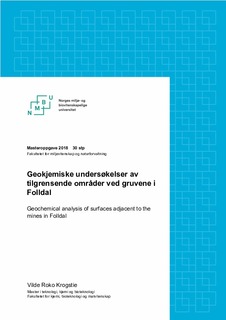| dc.contributor.advisor | Okkenhaug, Gudny | |
| dc.contributor.advisor | Almås, Åsgeir Rossebø | |
| dc.contributor.author | Krogstie, Vilde Roko | |
| dc.coverage.spatial | Norway, Folldal | nb_NO |
| dc.date.accessioned | 2018-08-15T11:02:55Z | |
| dc.date.available | 2018-08-15T11:02:55Z | |
| dc.date.issued | 2018 | |
| dc.identifier.uri | http://hdl.handle.net/11250/2558113 | |
| dc.description.abstract | Anthropogenic activities such as mining has led to an increase in and occurrence of heavy metals on the surface of earth. Mining has been an important part of the Norwegian industry for a long time. In the mines in Folldal, copper, zinc and sulphur were extracted. Today, the area surrounding the old mines are influenced by acid mine drainage (AMD) from the tailings, causing parts of the river Folla to be contaminated by heavy metals. In this thesis, the heavy metal contamination in soil and sediments in Folldal was evaluated and the bioavailability of the elements were estimated. The total concentration of copper (Cu), cadmium (Cd), zinc (Zn), lead (Pb) and iron (Fe) was determined in soil samples and pore water from the soil samples. The bioavailable concentrations were estimated using the Diffusive Gradients in Thin films (DGT) technique. The speciation of Cu in extracted pore water was estimated using the model WHAM VII.
It was only the total Cu concentration that were high enough to be classified as class 3 (moderate contamination) by SFT's manual. The speciation analysis showed that the copper in the pore water (Cupw) was mostly bound to colloidal fulvic acid (FA). When the pH was below 5.5 the fraction of free ions increased. When comparing CuDGT with Cupw it is evident that the bioavailable concentration may be higher that the concentration in the pore water. This is due to the fact that the DGT-unit accumulate free Cu-ions form both the pore water as well as the labile fraction of the soil. Although the total concentrations of Cu at one of the mine tailings were classified moderately contaminated (class 3), the concentration of DGT-labile Cu (CuDGT) were very low. Likewise, was the free Cu2+ in pore water negligible. Base on the findings in this study, the Cu contamination is posing insignificant terrestrial toxic risk. | nb_NO |
| dc.description.abstract | Antropogen aktivitet som gruvedrift har ført til en økt utbredelse og forekomst av tungmetaller på jordens overflate. Gruvedrift har i en lang tid vært en viktig del av norsk industri. Folldal gruver var et av gruveområdene som utvant kis inneholdende kobber (Cu), sink (Zn) og svovel (S). I dag er området preget av sur tungmetallholdig avrenning fra avgangsmassene. Denne avrenningen har ført til at deler av elva Folla, som renner gjennom Folldal, har blitt sterkt forurenset av tungmetaller. I denne oppgaven ble tungmetallforurensninger i jord og sedimenter rundt Folldal vurdert og biotilgjengeligheten av de ble estimert.
Totalkonsentrasjonen av Cu, kadmium (Cd), Zn, bly (Pb) og jern (Fe) ble bestemt i jordprøver og porevann fra de samme jordprøvene, mens biotilgjengelig konsentrasjon ble estimert ved bruk av Diffusive Gradients in Thin films (DGT). Tilstandsformene av Cu i porevannet ble estimert ved bruk av modellen WHAM VII.
De totale metallkonsentrasjonene viste at det kun var konsentrasjonen av Cu ved enkelte prøvesteder som hadde høy nok konsentrasjon til å bli klassifisert i tilstandsklasse 3 (moderat forurensing) etter SFTs veileder. Tilstandsformanalysen viste at kobberet i porevannet (Cupw) i hovedsak var bundet til kolloidal fulvosyre (FA). Resultatene viste tydelig at fraksjonen Cu bundet til kolloidalt FA minket ved pH lavere enn 5.5. En sammenlikning av CuDGT og Cupw viste at det det i noen tilfeller ble tatt opp mer Cu enn det som var tilgjengelig i porevannet. Dette kan skyldes at DGT-enheten akkumulerer litt Cu både fra de frie metallionene i porevannet og fra labile fraksjoner i den faste jordfasen. Selv om den totale Cu-konsentrasjonen ble klassifisert moderat forurenset (klasse 3) ved en av avgangsmassene, er konsentrasjonen av DGT-labilt Cu (CuDGT) veldig lav. På samme måte var konsentrasjonen av fritt Cu2+ i porevannet neglisjerbar. Basert på funnene i dette studiet utgjør Cu-forurensningen en ubetydelig toksisk risiko. | nb_NO |
| dc.language.iso | nob | nb_NO |
| dc.publisher | Norwegian University of Life Sciences, Ås | nb_NO |
| dc.rights | Navngivelse 4.0 Internasjonal | * |
| dc.rights.uri | http://creativecommons.org/licenses/by/4.0/deed.no | * |
| dc.subject | DGT | nb_NO |
| dc.subject | Acid mine drainage | nb_NO |
| dc.subject | Forurenset grunn | nb_NO |
| dc.title | Geokjemiske undersøkelser av tilgrensende områder ved gruvene i Folldal | nb_NO |
| dc.title.alternative | Geochemical analysis of surfaces adjacent to the mines in Folldal | nb_NO |
| dc.type | Master thesis | nb_NO |
| dc.source.pagenumber | 54 | nb_NO |
| dc.description.localcode | M-KB | nb_NO |

